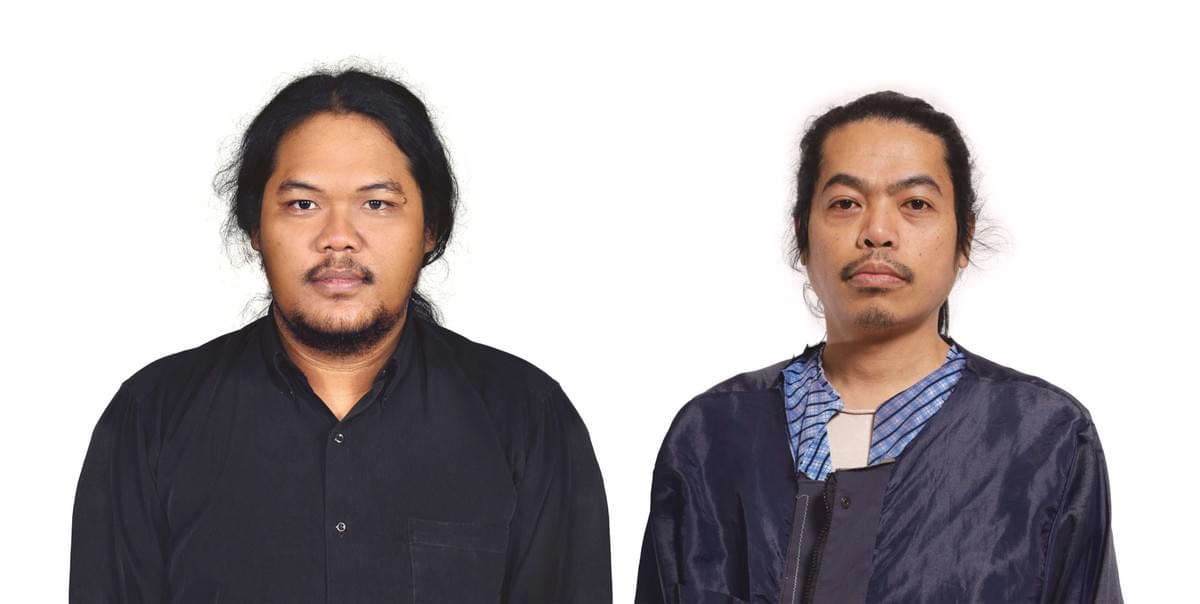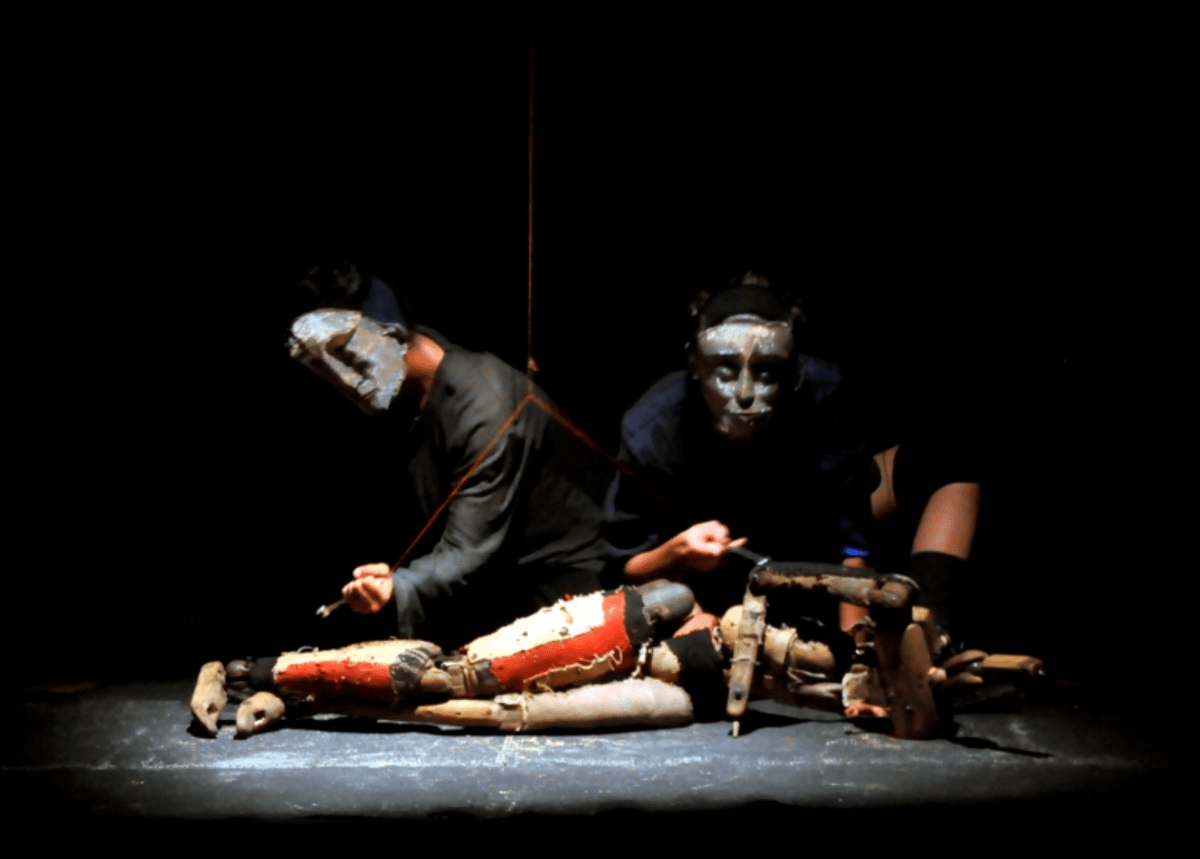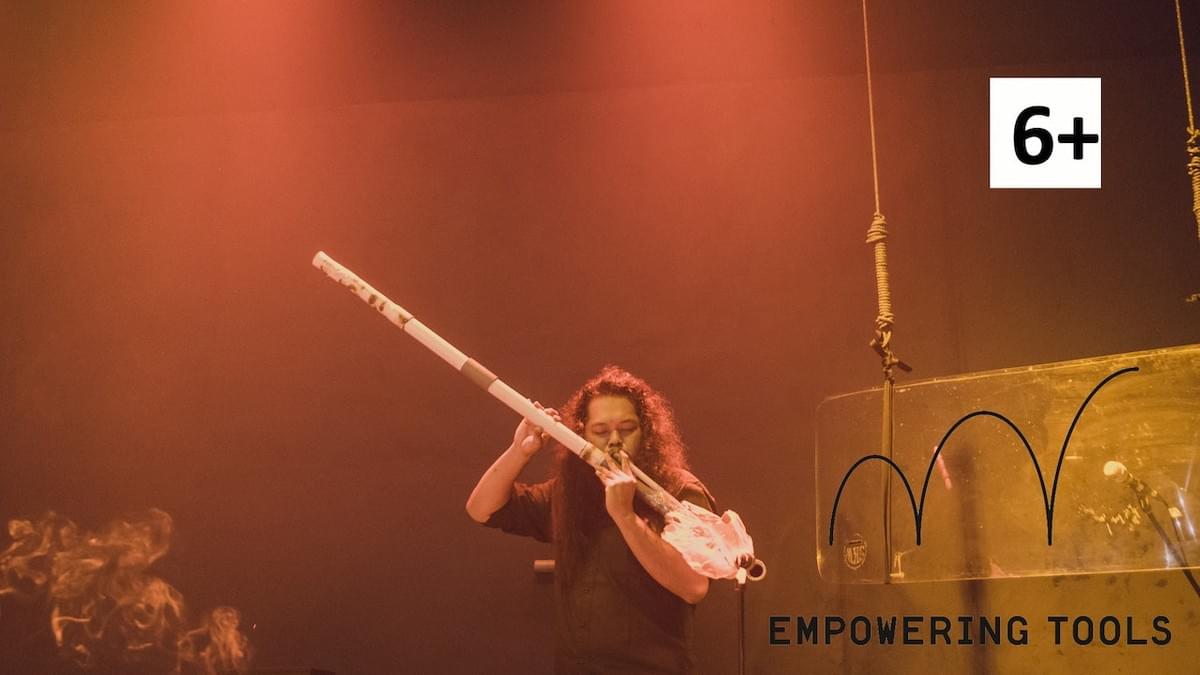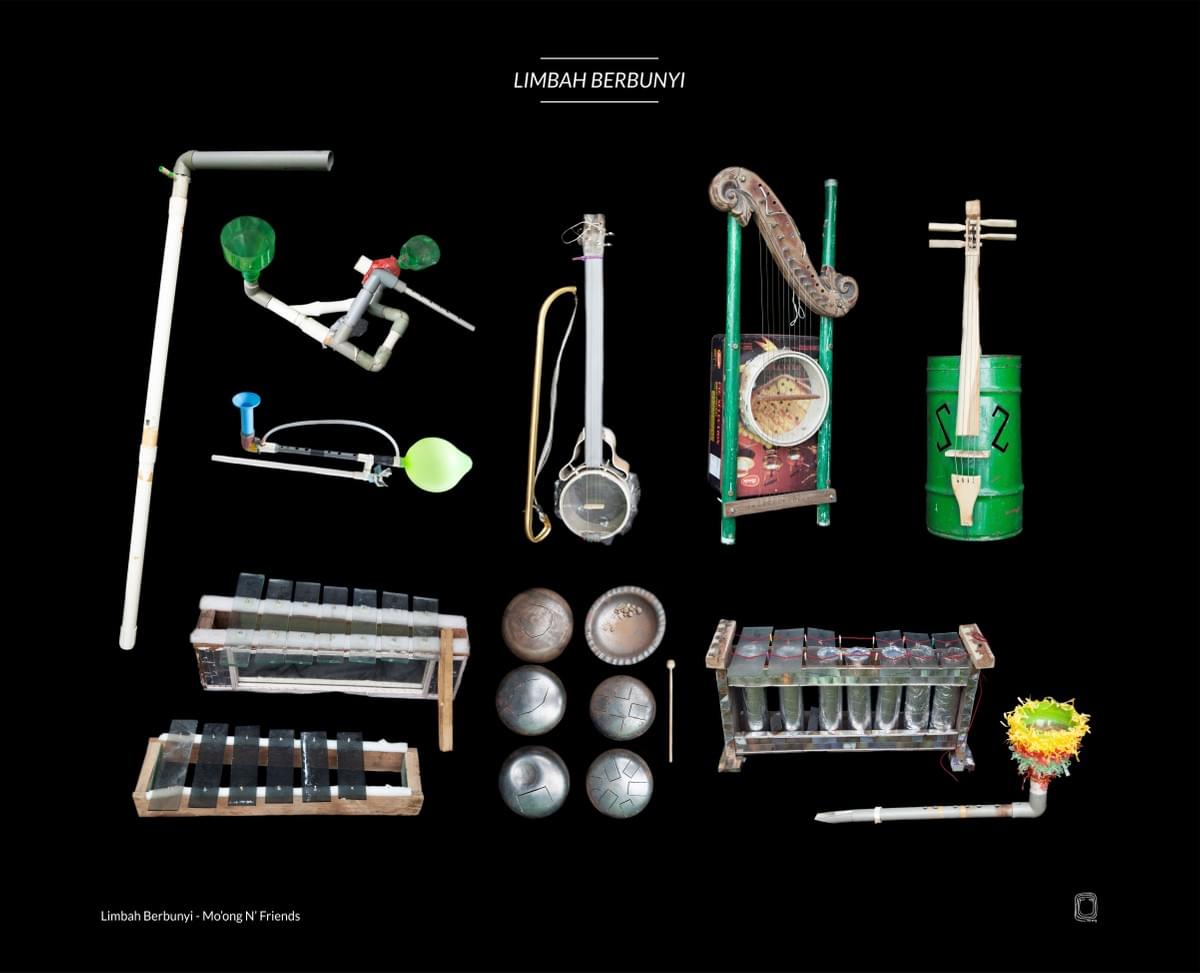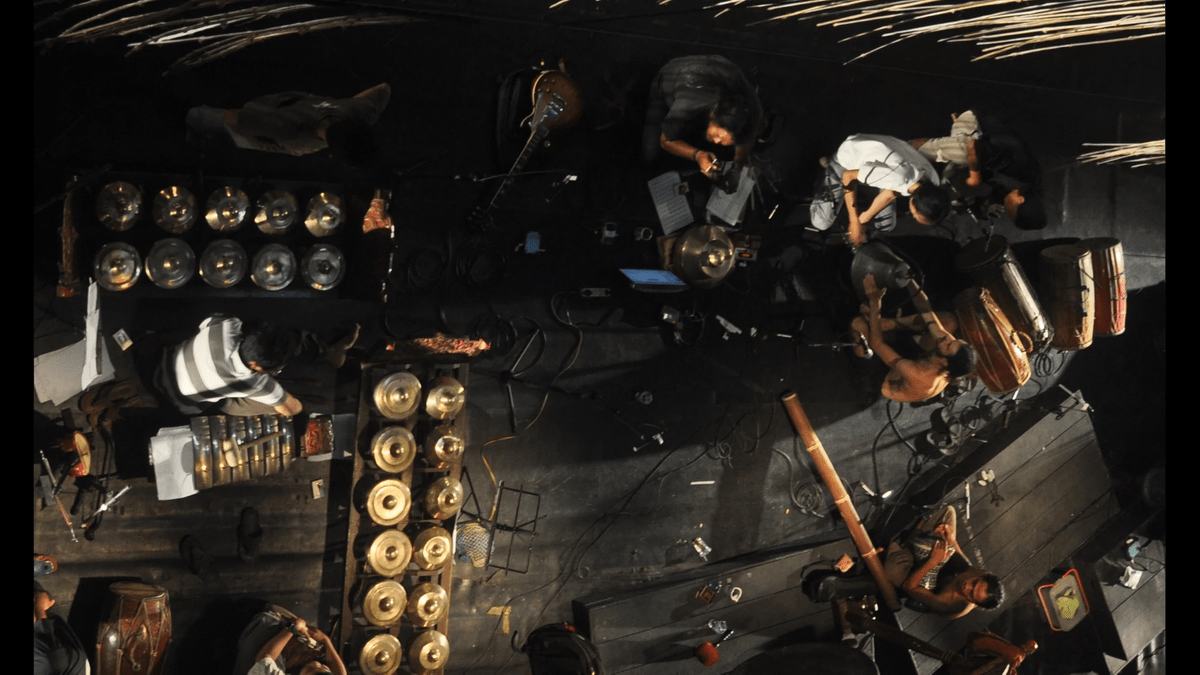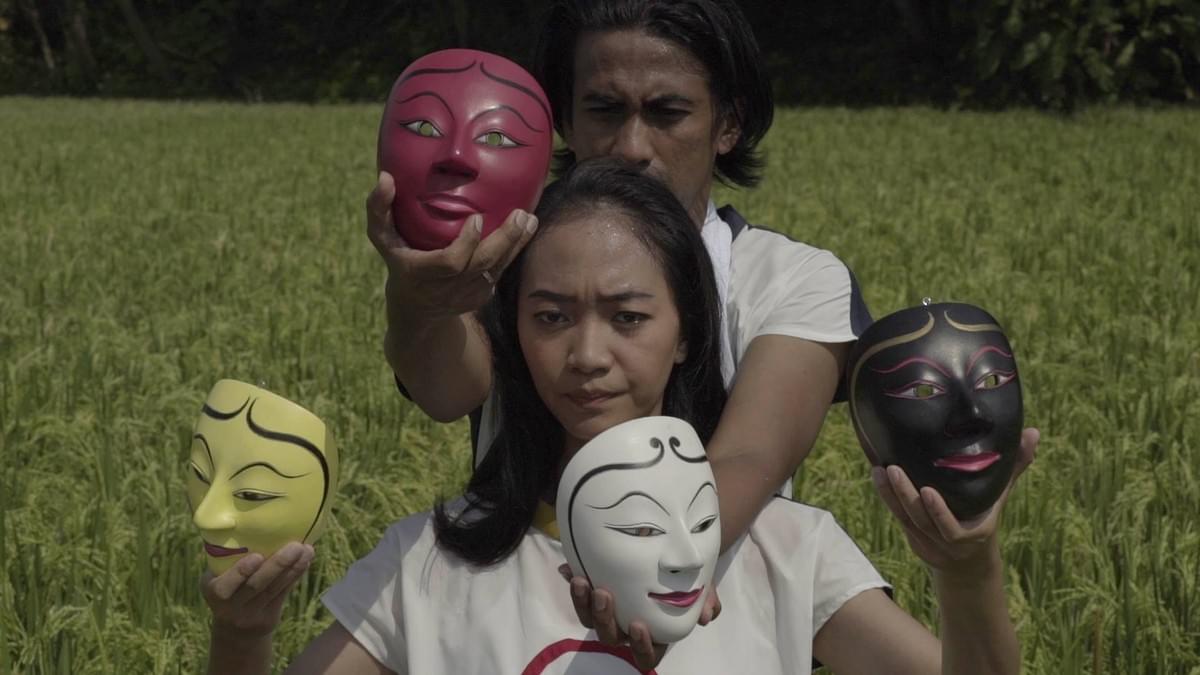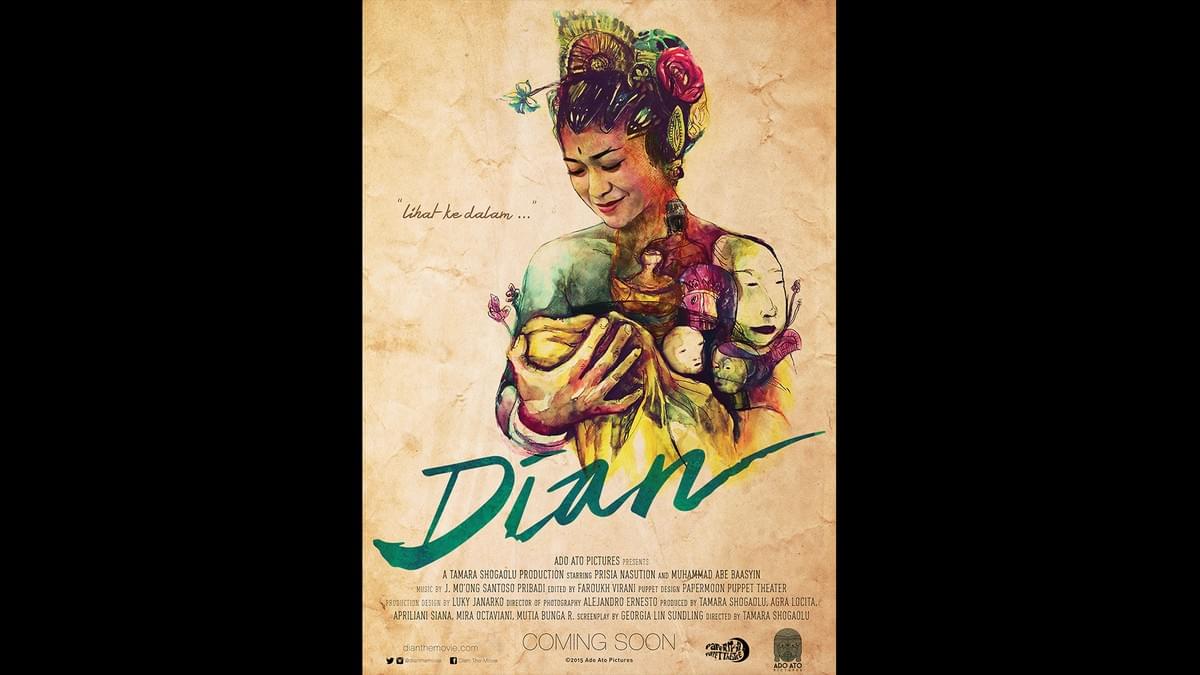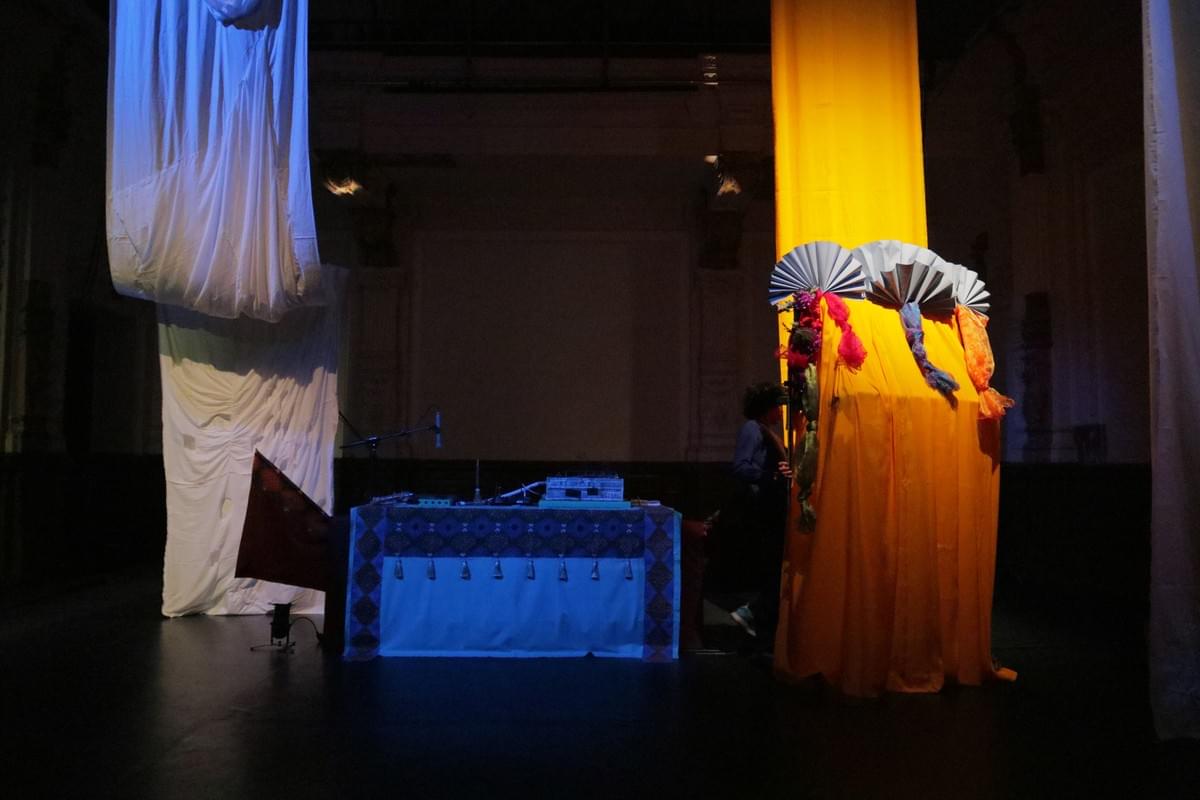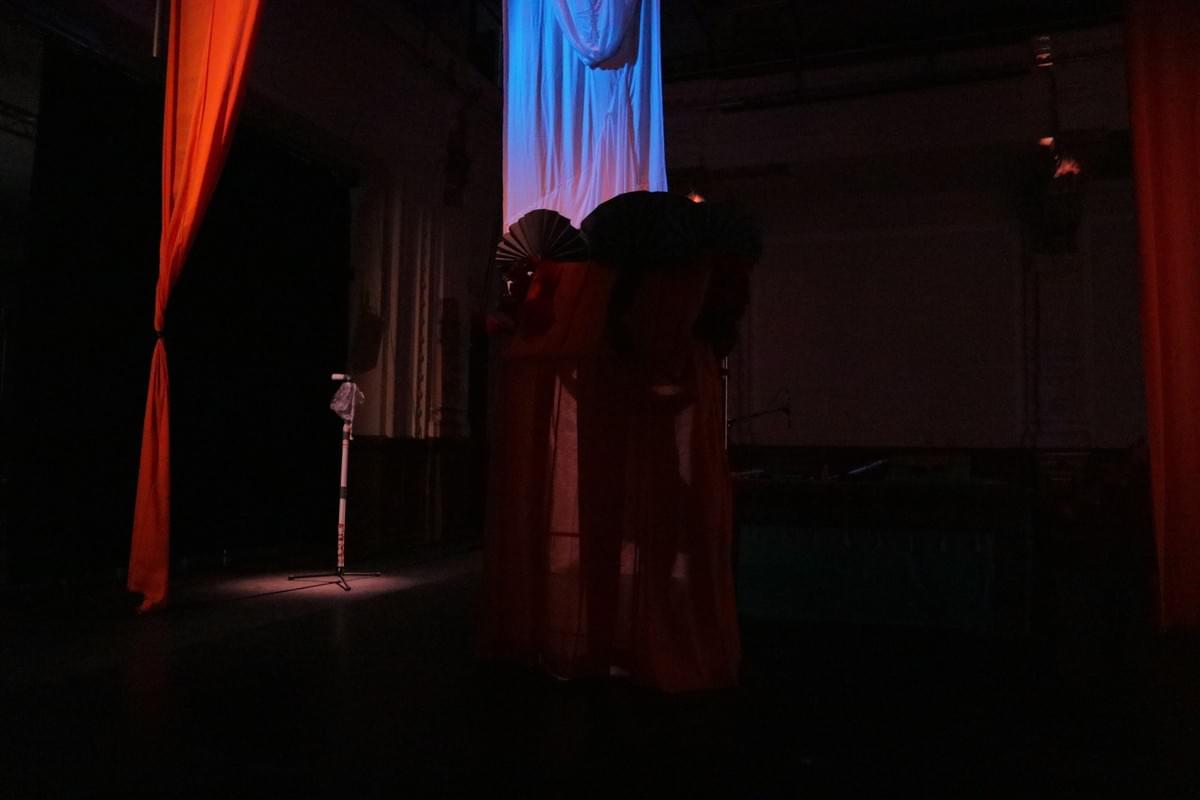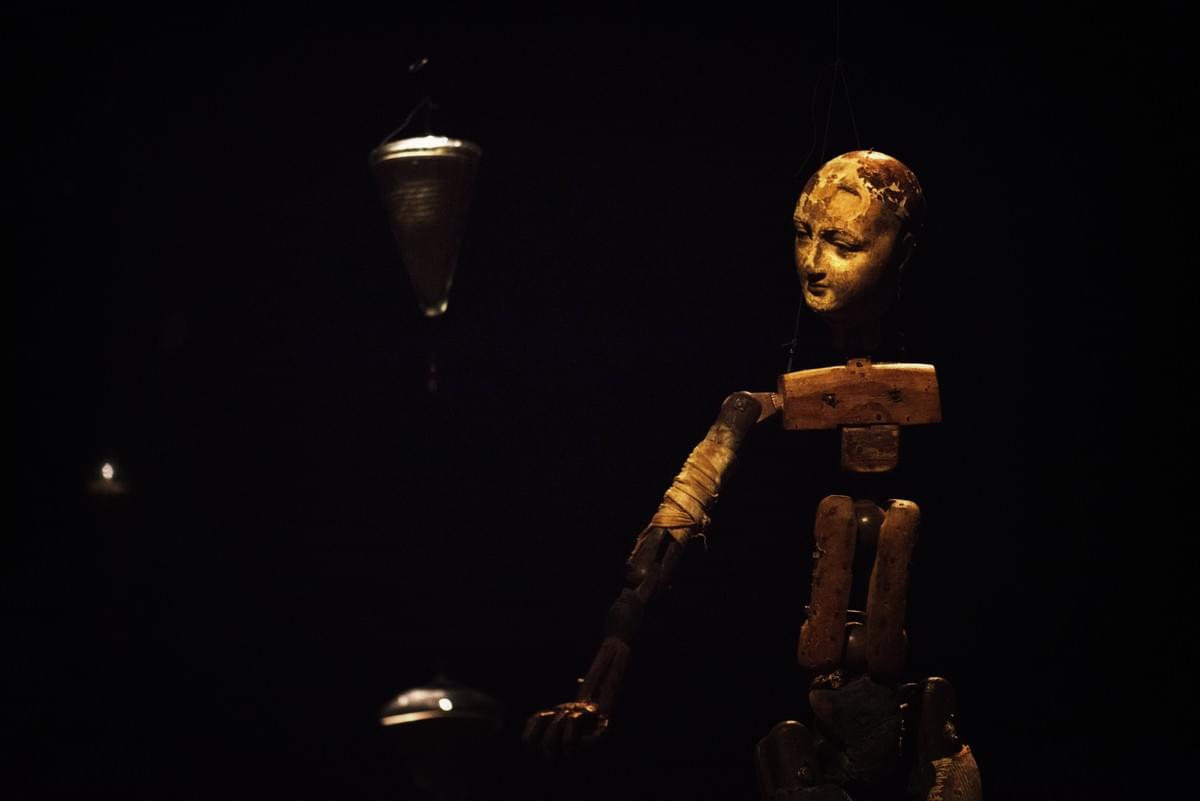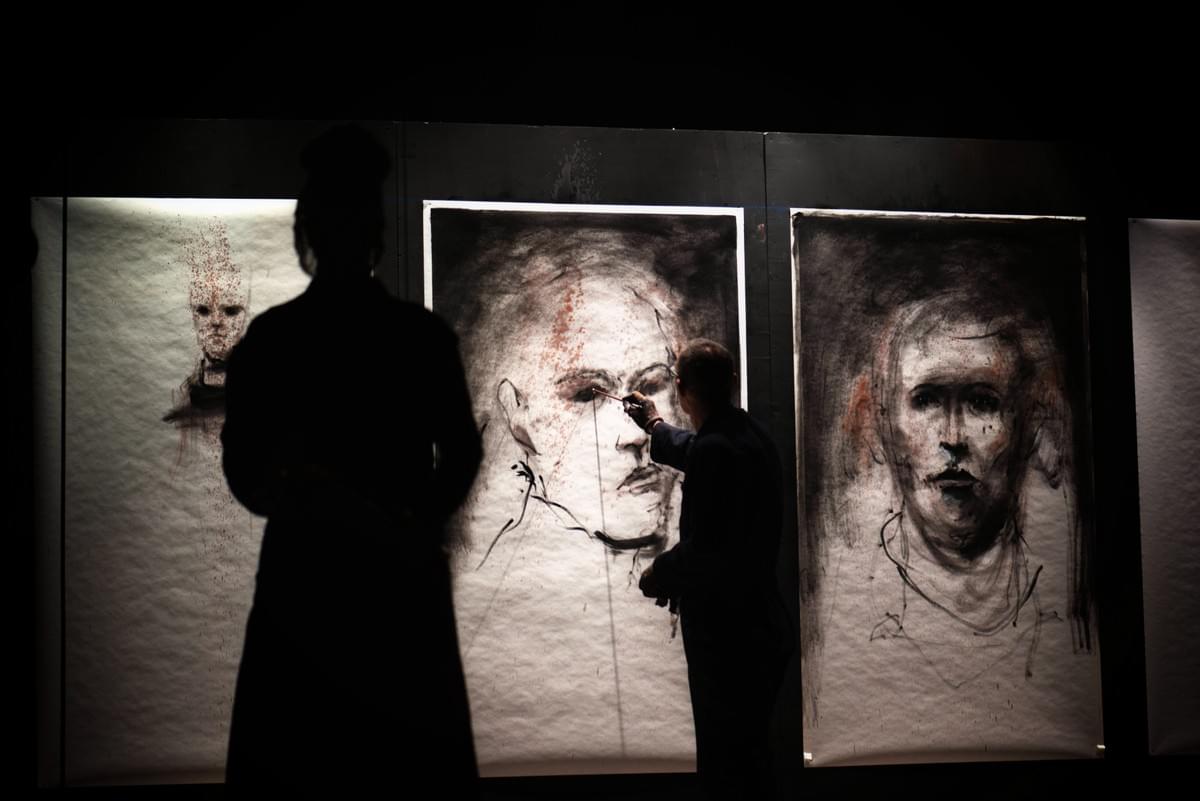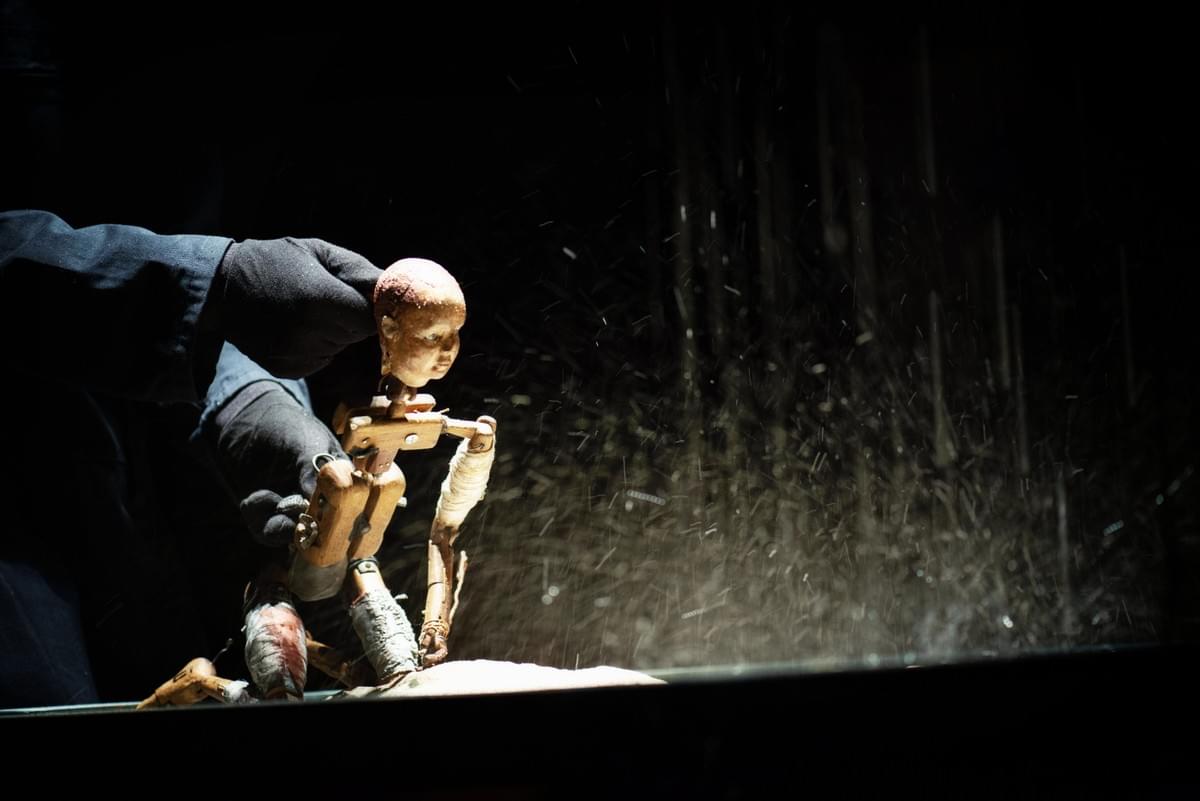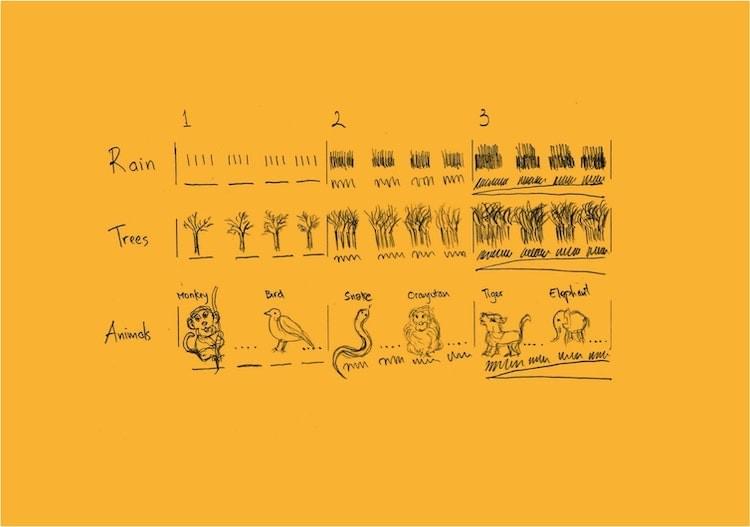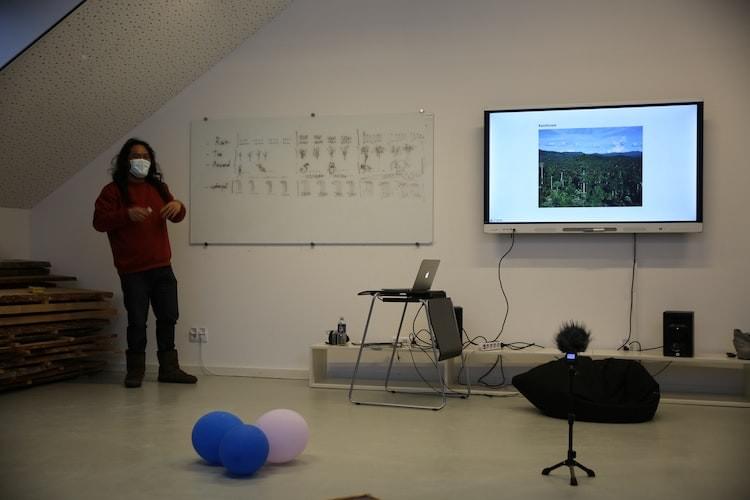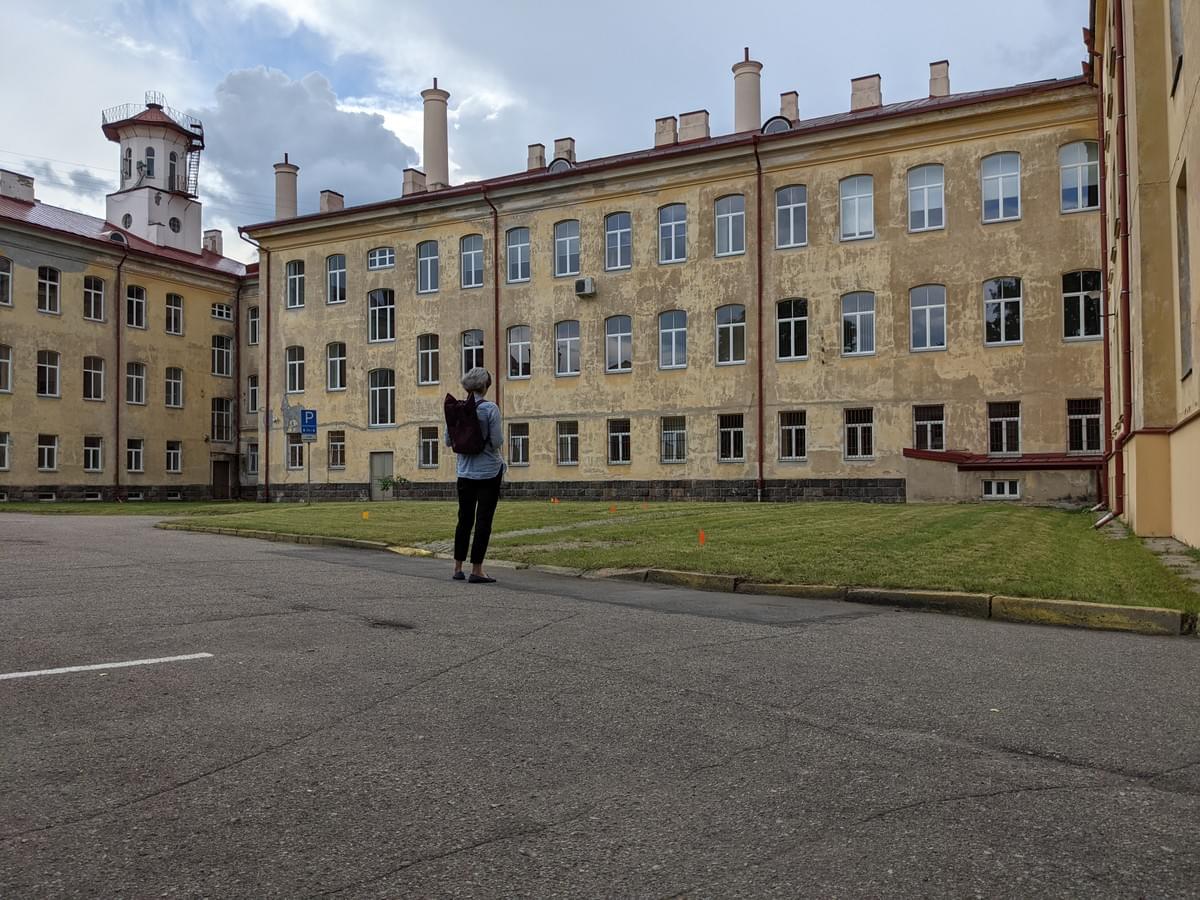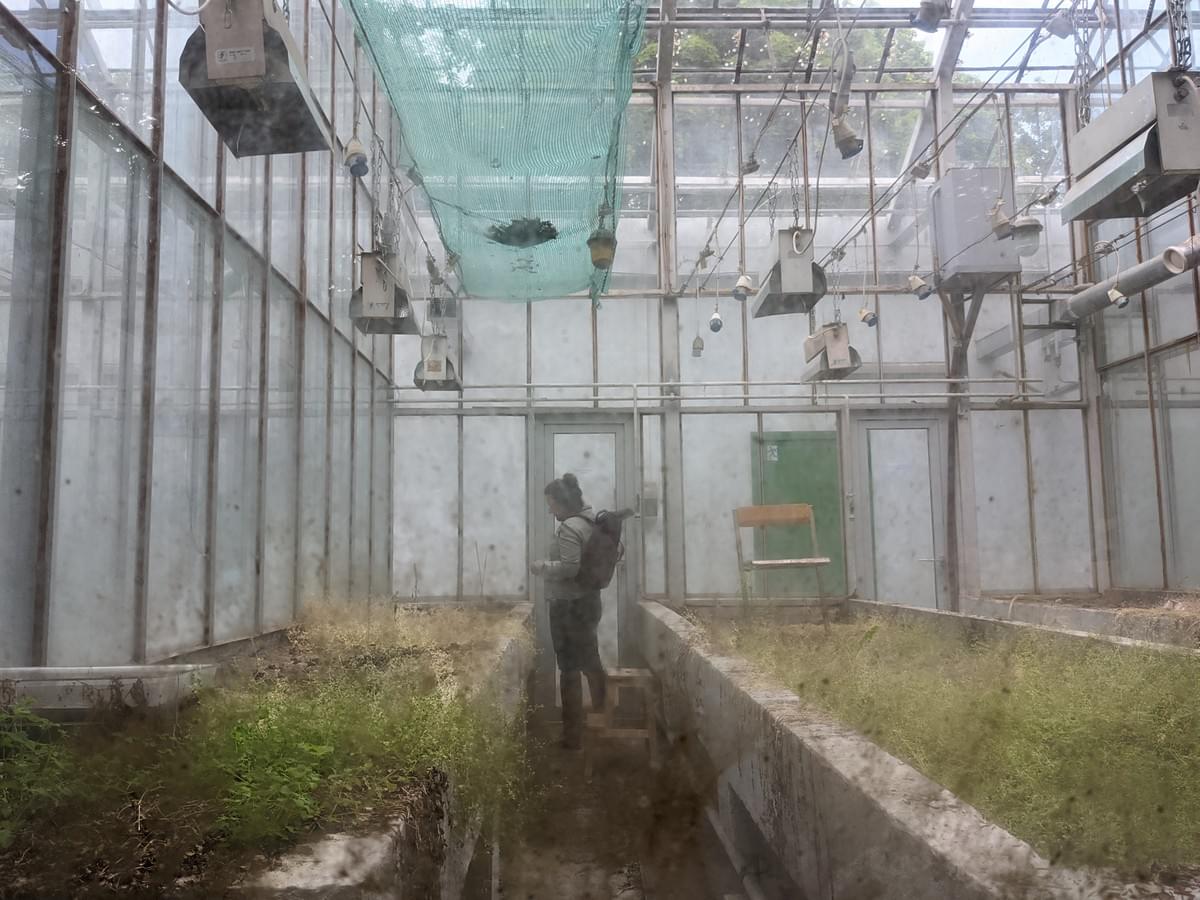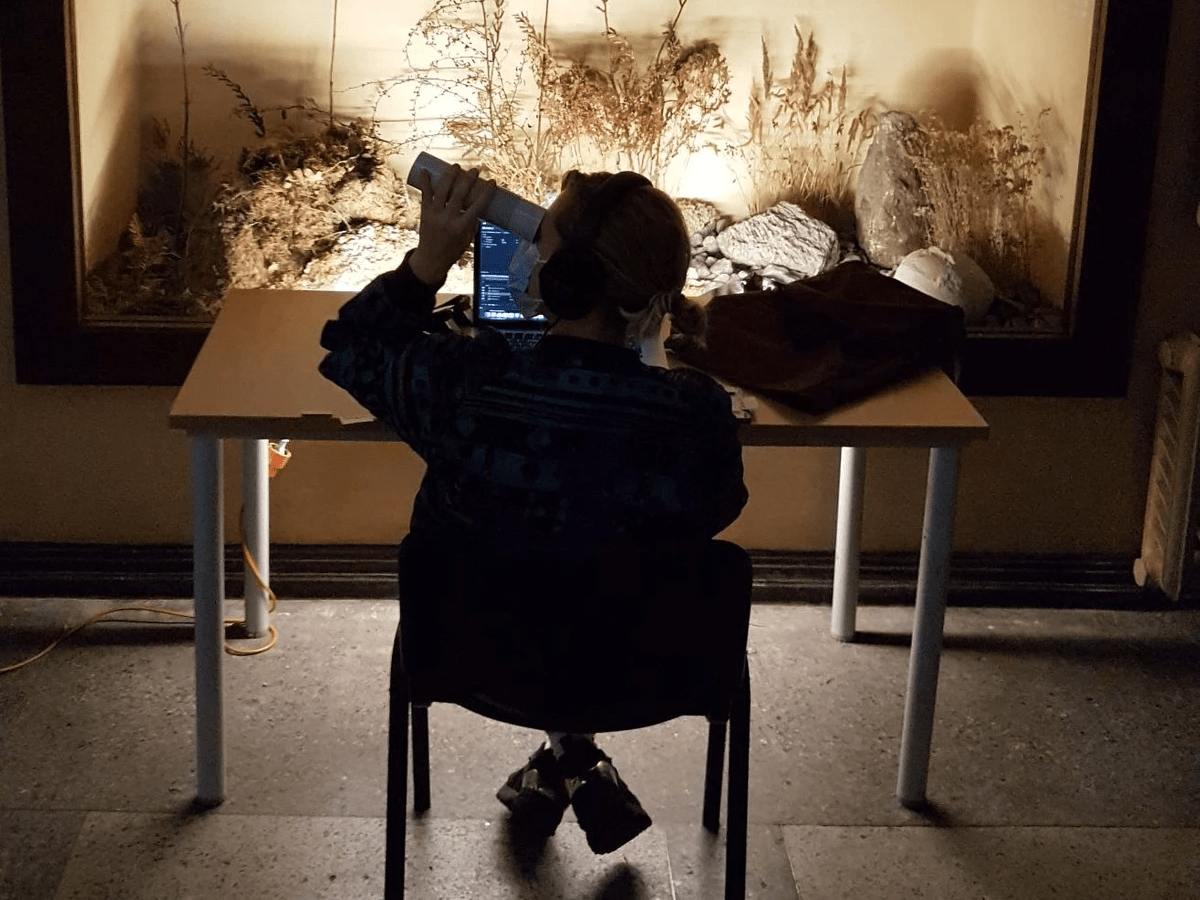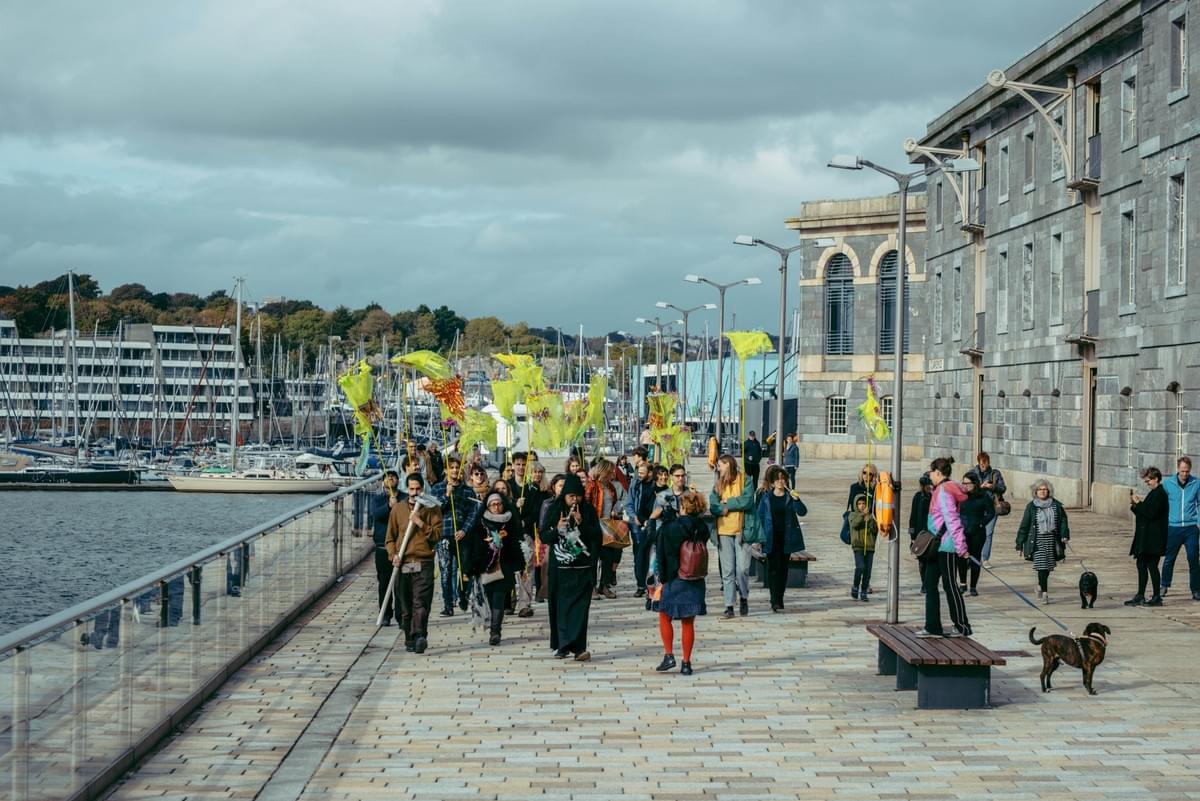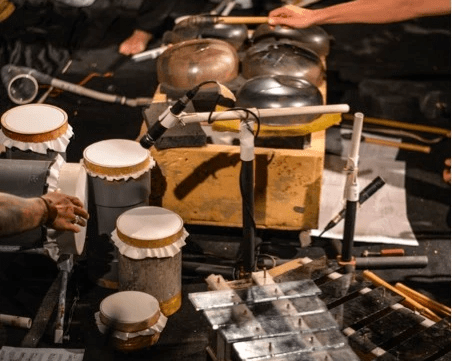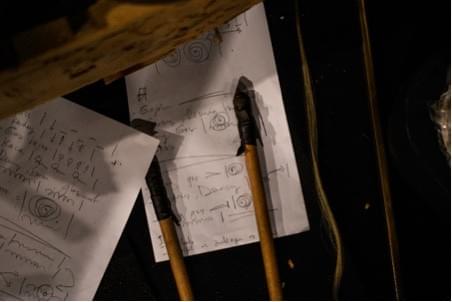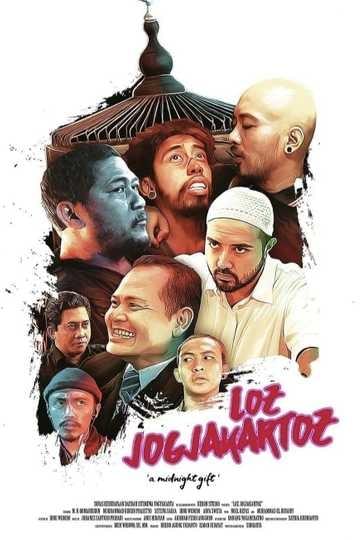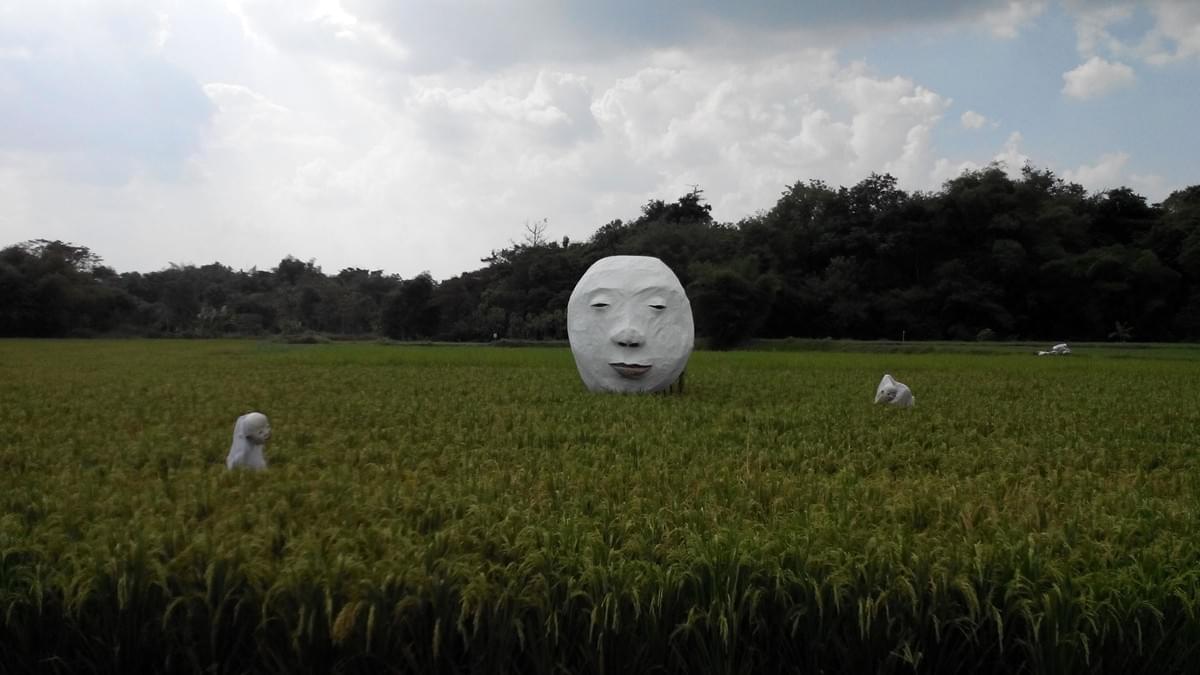









DECOLONIAL FREQUENCIES
OVERLAPPING WAVES
Sound performance by J. Mo'ong Santoso Pribadi & Pepe Dayaw

The continental, imperial thinking covers the landscape. Hills and valleys are measured, sounds and relationships are measured. But is that even possible? What if this landscape is mostly water, if the in-between and the liquid rule life? When the currents get confused and your own position is constantly shifting? Can one develop one's own resistant art from this experience?
Mo'ong is a composer and instrument maker, Pepe Dayaw is a performer and fashion designer. Both grew up in an island country – Indonesia and the Philippines. The Philippines consists of 7102 islands, Indonesia of 17,508 islands. Both start from “left-overs” in their art. What is perceived as residue in the logic of consumption and status becomes new media in her hands: Mo'ong uses them to create instruments and new sounds, Pepe dresses, costumes, performances. Improvising and experimenting with what is there, they leave the 'standard' behind to create new bodies of sound, media of expression and resonances. The 'standard' is an imperial setting, not only in Indonesia and the Philippines. Working with the leftovers is politically resistant,
For Overlapping Waves , J. Mo'ong Santoso Pribadi and Pepe Dayaw come together for the first time at Ballhaus Naunynstraße. Sound composition and performance art: The fluid, the archipelagic in-between are decisive, the encounter, the complement from different directions. Together they create their composition from things and sounds, from artefacts and rhythms - always looking for a liquefaction of the imperial order, for an opening to a self-determined unpredictability.

By & Featuring: J. Mo'ong Santoso Pribadi & Pepe Dayaw
Co-director: Julien Enzanza
Production Manager: Camila de Abreu
A production by Kultursprung in the Ballhaus Naunynstraße Gemeinlasting GmbH. Funded by the State of Berlin, Senate Department for Culture and Europe as part of the Decolonial Frequencies festival.
World premiere: Thursday, April 14, 2022
GAUNG
Contemporary Puppet Theater

Born patiently between France and Indonesia, Gaung, a meandering room is the culmination of an evolving project. Nestled in its heart is a strange artist's mannequin serving as a model for a painter in the 19th century. On the path of a visual and sensory theater, the Autumn 2085 collective weaves the story of a painter and his favorite model, unless it is his own and that of his creator. The immersion in the process of fascination at work is created directly: the painter stands in the distance, composing his canvases, like J "Mo'ong" Santoso Pribadi who delivers a haunting and incantatory music, entirely in the accompaniment of the visible and of the unseen. Beneath a bamboo structure, the mannequin-model connected to glass hourglasses digs into herself the multiple figures that have settled on her wooden frame. A metaphor of the radical and absolute disappearance of the loved one is tied, of the ultimate crack as of the reconstruction of the intimate. In an active and inspiring contemplation, this theater for puppets and characters of flesh and bone stretches time to better fragment reality on the shattered reflections of the cracks in beings. Identities are revealed to be shifting, carnal images abundant, the present dislocated and reality fragmented.


MAKING SOUND - MUSIC
Making Sound-Music using Mind-Body connection, by combining sensing, feeling, thinking, and action.

Learning kit for primary school children "Making Sound-Music"
This project is about musical perception, a cognitive activity, is directly connected with music listening and musical performance. Human perception processes and transforms physical input (such as visual,soundscape, etc) into cognitively constructed meaning such as pitch, melody and rhythm. It is worth noting that perception is also influenced by context, culture, and personal experience.
Embodied learning is a way of learning that draws on bodily experiences. Bodily Exploration of Sound-Music with learning experiences originate in exploring some musical subject or phenomenon. This exploration includes exercises that combine listening, watching, moving, singing, thinking, improvising and imagining, a variety of mind-body involvements within given musical culture.

You can use these free learning materials to practice making sounds from objects around you, create sounds from associations with a place, listen and respond to soundscape recordings, and create a space for freedom of expression during group activities.
The learning kit includes a lesson plan, activity guidelines, presentation materials and audio recordings. The activities are rooted in playful expression and the principles of embodied learning.
Produced within the framework of Empowering Tools project and residency at Nida Art Colony (NAC) of Vilnius Academy of Art, 2022.
https://www.rigabiennial.com/en/education/education-kits/making-sound-music
A PRIMER ON OBSERVATIONAL PRACTICE
Sound & Self Performance


A project initiated by Vilnius University Culture Center, in which a team of artists: director, dramatist Saulė Norkutė, scenographer Šarūnė Pečiukonytė and contemporary music composer, sound designer J "Mo'ong" Santoso Pribadi (Indonesia) invites one participant to try their observation practice methodology. This observation primer in audio guide format (Lithuanian and English) stimulates imagination, teaches attentiveness and creates a unique observation experience, which all members of the VU community, as well as city residents and visitors from the age of 14, are invited to try.
How important is the ability to observe for a person? According to the creators of the audio guide, observation is not action, observation is withdrawal. Observation as a research method cannot be questioned, it just needs to be practiced and then all the right answers come. Observing the environment means seeing many different time directions, courses, prehistory, working living organisms and other elements.
We invite you to become an intern of this methodology and take the first steps towards a more careful and comprehensive observation, develop this habit and apply it daily. During a little more than an hour-long session, you will not only walk around the closed territory of Vilnius University, located on MK Čiurlionos Street, but you will also become temporarily invisible to buildings, passers-by or even sidewalk tiles.
Practice takes place outside, Vilnius University MK Čiurlionio str. in the territory of 21/27 yards. Start - the lobby of the Vilnius University Palace (entrance from MK Čiurlionios str. 21).

COOK’S NEW CLOTHES

250 years after the ‘First Voyage’ of James Cook to the Pacific, Cook’s New Clothes marks the occasion in September 1768 when Joseph Banks and Solander (the voyage artist) boarded the Endeavour ship in Plymouth, through a procession on the banks of the River Tamar, including a naval uniform made out of dog furs (with Maori artist Keren Ruki) and a Maori cloak woven from plastics, gathered from the Pacific Ocean. The processional walk from Devil’s Point to a video installation and in the Royal William Yard is a participatory performance in which an orchestra of trash instruments (Limbah Berbunyi, composed by J Mo’ong Santoso Pribadi) accompanies the carrying of objects, walking and playing sounds with the artists. The procession will follow a performance lecture, Stubbs’ Dingo, where Jessyca Hutchens and Tamara Murdock will speak to George Stubbs’ Portrait of a Large Dog, presenting stories of the Dingo that both pre-date and follow the paintings creation and the colonisation of Australia.
Cook’s New Clothes is a collaboration between Khadija von Zinnenburg Carroll and Keren Ruki, with Simon Layton, Ruby Hoette, Ludovica Fales, Nikolaus Gansterer, Kirill Burlov, Mo’ong. This group of international artists will be joined by the general public in an event that turns recycled materials from the Pacific Ocean into performance and sound.
https://www.abc.net.au/radio-australia/programs/pacificbeat/cooks-new-clothes/10450306
https://frieze.com/article/atlantic-project-excavating-plymouths-failed-utopias
https://coolhunting.com/culture/the-atlantic-project-brings-art-and-reflection-to-plymouth/The processional performance commemorates Tupaia the Tahitian priest, navigator and translator that boarded the Endeavour, which departed Plymouth in 1768. This group of international artists were joined by the general public at the National Maritime Museum in an event that turned recycled materials from the Pacific Ocean into performance and sound. Assembled to critically reimagine and reconfigure the departure of Captain Cook’s Endeavour 250 years ago in a processional performance on the banks of the river, the participatory performance in this video began in the Queens House. The installation includes the collateral of these performances, including the dingo sound and uniform in the first rooms, the cloak for Tupaia, and trash instruments to interact with.
A film project by Khadija von Zinnenburg Carroll
Director of Photography – Ludovica Fales
Music – J "Mo’ong" Santoso Pribadi
Costumes – Keren Ruki
Dancer – Kirill Burlov
Drawings – Nikolaus Gansterer
Musicians – Simon Layton, Hana Qugana
Lead Carriers – Ruby Hoette, Emma Hoette
Camera – Ludovica Fales
Editing – Martina Moor
Additional cameras – Khadija von Zinnenburg Carroll, Claire Loussouarn, Niza Ester Ritzvi, Raffaele Nocerino, Charlotte O’Donnell
Additional Musicians – Keren Ruki, Jo Walsh, Jack John Maurirere, Khadija von Zinnenburg Carroll, Chris Moffat, Julia Binter, Naomi Vogt, James Peachey
Additional Carriers – Azadeh Sarjooghian, Abigail Jacqueline Jones, Martha Flemming, Imma Ramos, Alex Wolfers, Katy Barrett
Additional sound – Khadija von Zinnenburg Carroll, Nikolaus Gansterer, Jessyca Hutchens
Procession participants – Jody Toroa, Kay Robin, Stuart Blyth, Maria Amidu, Dimitri de Preux, Mark Condos, Leslie James, David Lappano, Islay Shelbourne, Tamara Murdoch
Rowers – Billy Smith, Brian Denholm, Cam Taylor, Carolyne Dick, Clare Lissaman, Elaine Tan, Jen Szeto, Lara Collins, Lawrence Vaike, Louise Harkness, Nikki Petelo, Paula De Ceglie, Sarah Ho, Siobhan Thomas, Susie Turner, Tala Petelo, Thor Harley.
LIMBAH BERBUNYI PROJECT
Music Ensemble/Collective

Gongs made of gas bottles, bagpipes of plumbing offcuts, a biscuit tin sitar, PVC pipe elephant trunk roaring, oil gallon double base, flute of plastic waste, toothbrush guitar fret, broken window pane gamelan instruments. Limbah Berbunyi are a collection of trash instruments, made of retrieved waste. Limbah Berbunyi is also the score of an hours long piece of music, written in four parts by J. Mo'ong Santoso Pribadi, and played by various musicians in the band Mo'ong and Friends. The instruments were built in a collaboration with Muhammad Sulthoni Konde, an expert in recycling waste into art objects. It is a collaboration in sound made within the image of the sound producing objects. As environmental activist, Konde's particular interest is in making non-biodegradable trash useful again. Together they have designed instruments that can be played acoustically, and are a mix of the instruments of the Indonesian Gamelan and of European flutes, violins, double bass.

Each instrument has an onomatopoeic name, this is predominantly how names are made in Indonesian: Pret, Gajah Pipa, Blek Siter, Tong Bass, Demung Kaca, Saron Kaca, Slenthem Kaca. The name follows the Rasa (sense) of the sound produced. The composition is written in symbolic drawings, rather than notes. The pattern is comparable to the gamelan, but using trash frees it from the necessity of traditional patterns that the gamelan conventionally uses. At its core, this subversion of any commodifiyable tradition brings this into the space of experimental sound and contemporary installation art.
The performance of Limbah Berbunyi reveals a surprise in that the instrumental music does not sound like trash. One could be a bagpipe, or a Slompret (a traditional instrument from East Java) which sings, or rather, is sung, while the audience wonder about its origin. The bagpipe, for example, sounds like traditional Indonesian flutes: Pui-pui (Makassar,South Celebes), Serunai (Minang,West Sumatra), Slompret (East Java), but it is played on the Javanese Slendro scale.
MASK
Contemporary Music & Performance
Composer & Director : J "Mo'ong" Santoso Pribadi
GHOSTS OF HELL CREEK
Prehistoric Body Theater is deep-time animal dance, celebrating the 500+ million year old evolutionary story of the vertebrates, told through the visceral biology of the human body in motion. Interdisciplinary artistic director Ari Rudenko has teamed up with Dr. Greg Wilson, the Burke Museum Curator of Vertebrate Paleontology, and an international ensemble of Seattle based dancers, to stage the evening length work GHOSTS of HELL CREEK.
66 million years ago, a massive asteroid struck the Earth with the force of a billion Hiroshima bombs, inducing an apocalyptic extinction which ended the 150+ million year reign of the dinosaurs, and marked the dawn of the age of mammals. GHOSTS OF HELL CREEK tells the story of Acheroraptor temertyorum, the last of the fierce bird-like raptor dinosaurs, who roamed the Hell Creek flood forests of prehistoric Montana before their obliteration in the terrifying impact. GHOSTS OF HELL CREEK then tells the survival story of Purgatorius unio, our earliest known primate ancestor, who rose from the ashes of the extinction, and thrived on the first fruit, as the world was born anew.
Directed by Ari Rudenko
Dancers: Shrikant Adhikarla, Josh Yee, Jiaqi Kyki Li, Zakkir Abdul Rahman, Lela Besom, Pongkhi Bujorbarua, Kenneth Telesco, Jeremy Chan.
Music: J Mo'ong Santoso Pribadi, Ari Rudenko
Lighting: Peter Bracilano
Set and Costume: Ari Rudenko
LOZ JOGJAKARTOZ
Movie Scoring

TENDENCY TO COLLAPSE
Movie Scoring
A metaphorical tale about uncertainty, changeability and dynamics. Coincidences and accidents. Scale and model. Gravity, arrows, ruins – collapse.
The protagonists, chased by fate, run away to the forest. Nature gives them shelter. In order to blend in with the greenery, they change their bodies, faces, hands. In the end, they cannot recognize themselves.
The film is inspired by Javanese culture, including traditional dance, local martial arts – pencak silat and story of Prince Panji and Princess Candra Kirana, popular in Southeast Asia.
Screenplay: Marta Węglińska
Cameraman: Adi Semali
Music: J Mo'ong Santoso Pribadi
Edit: Adi Semali
Sound: J Mo'ong Santoso Pribadi
Cast: Anter Asmorotedjo, Anita Listyaningrum, Ruben Pangingkayon, Marta Weglinska
DIAN
Movie Scoring

Unable to conceive a child, a desperate woman turns to dark magic to save her marriage.
Dian (Prisia Nasution) is a woman trapped in the mundane expectations of daily life in her traditional Javanese village in Indonesia. Her marriage to Arief (Muhammad Abe) has grown cold, and she longs for love and affection. When Dian is unable to bear Arief children, his parents arrange for him to take on a second wife. Desperate, Dian seeks the help of a powerful shaman, in hopes that he can help her become pregnant. The shaman refuses. Left with no other options, Dian steals an object powered by dark magic, which ultimately leads to the truth that frees her.
Seen At: Cannes Film Festival, Chicago Feminist Film Festival, Los Angeles Asian Pacific Film Festival
Contact :
moongsoul@
